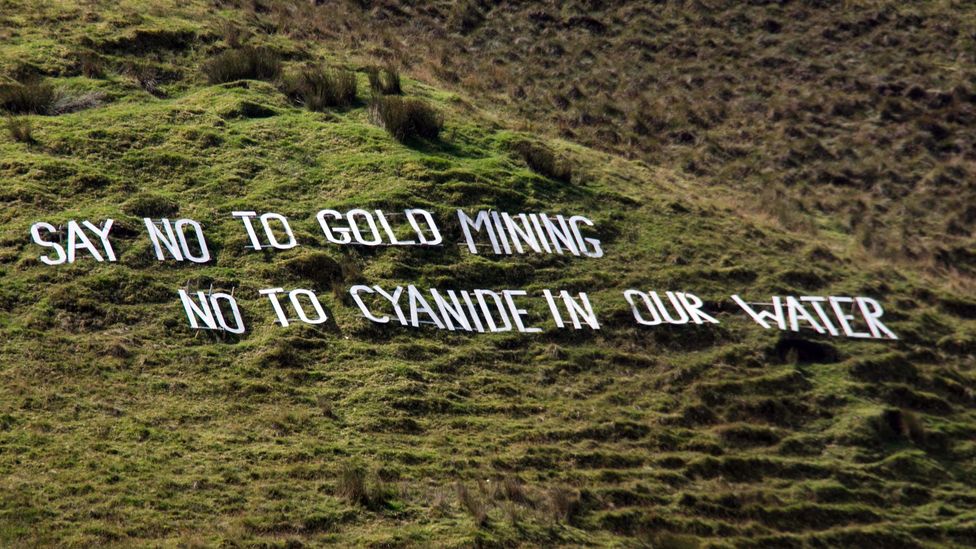Something that says gold should rise as would bitcoin, at the margin
And pretty countrysides tee-ed up, as luxury of abeyance runs dry
But, yes, below are not salmon spawning grounds, and i cannot imagine cyanide and salmon go well together
However, because fiat money inflation runs, so does gold, and at some juncture, salmon is trumped as natural consequence of wastelism
In the meantime, must note, that the ‘blight’ of tailings is why we must express support for DRD, for it is in effect doing environmental remediation, by taking out the last bit of goodness and revert the sites to what was.
But campaigners continue to express concerns that chemicals could be washed into nearby rivers and harm local wildlife. Pollution from the mine could also negatively affect people’s health, they claim. And they also fear that a large heap of “tailings” – waste material extracted from the mine and left aboveground – would blight the area’s scenery.
bbc.com
Why it’s getting harder to mine gold

By Chris Baraniuk27th October 2020
The price of gold has rocketed during the pandemic, but mining it is getting more difficult. Chris Baraniuk reports on challenges and controversy at one of the UK’s biggest planned mines.
For 1,000 days, the caravan stood with banners and placards pinned to its side: “We are not afraid. This is our land. This is our home. We will die for it.” Irish flags flutter in the wind. This is the anti-gold mine protest site set up by a group of locals in County Tyrone, Northern Ireland.
With 460 million-year-old veins of gold strewn hither and thither in the rock deep underfoot, the prospect of a mine in Curraghinalt, in a remote corner of the Sperrin mountains, has been talked about for decades – but it has never yet materialised. A recent application by a mining company to extract the seams of precious metal, has brought the prospect closer still. If successful, the firm says it could bring new jobs and money to the area. But many here want to keep things the way they are.
“I devote all my time to this campaign, I just feel it’s our future,” says Fidelma O’Kane, a retired social worker and lecturer who is concerned about the potential environmental impacts of the mine.
“My main worry is that the water will be poisoned, the air will be poisoned, the land will be contaminated – and ultimately people’s health will suffer,” she adds, explaining that she would never accept a mine, of any kind, in this area.
The company hoping to extract precious metals here, Dalradian Gold, says that it has put in place a swathe of environmental safeguards, and promises several economic benefits for locals. Still, the online planning proposal for the mine has attracted tens of thousands of comments, mostly negative, and a public inquiry will now take place to decide what will happen next.

Some in the nearby settlement of Gortin have objected to the planned gold mine (Credit: Alamy)
Heralded by some as a potential boon for Northern Ireland, where jobs and investment opportunities stagnated during the 30-year period of conflict known as the Troubles, experts say Curraghinalt could become home to the largest gold mine in the UK, were it to go ahead.
The question now hovering over the rolling Sperrins is, what is more valuable: keeping the gold in the ground, or taking it out?
This query could hardly be voiced at a more pivotal moment. The price of gold rocketed during the pandemic, spurring renewed interest in excavation projects and even an illegal mining boom in parts of the Amazon rainforest. Yet gold is proving ever-more difficult to release from the ground. The technical challenges may be well known, but environmental protests and local politics are less predictable. At what point does mining gold stop being worth the effort?
You may also like:
The controversial plan to fill a mine with nuclear waste Inside the hunt for a million-dollar haul of ocean gold The gold mine at the end of the worldLast year, global gold production fell by 1%, the first decline in a decade, according to the World Gold Council, which promotes the gold industry. Some analysts argue we have reached “peak gold” – which means that the maximum rate of extraction has passed and the production of gold will continue to fall until, eventually, mining for it shall cease entirely.
However, demand for the stuff shows no sign of slowing down.
“It’s kind of a perfect storm,” says Matt Miller, vice president of equity research at CFRA Research, an investment analysis company. “Or, a better way to say it is, the fundamentals for gold may never be stronger than they are now.”
According to CFRA, about half of the world’s gold, excluding that still buried in the ground, is used in jewellery. As for the other half, one quarter is held by central banks and a final quarter is owned by private investors or used in industry.
Miller is among those who believe we have reached peak gold. The price of a single ounce of the glittering yellow metal breached $2,000 (£1,550) this summer and still rests comfortably above $1,900 (£1,470). Twenty years ago, the same ounce would sell for less than a quarter of that amount. The latest surge, following the emergence of Covid-19, has been linked to weakening currencies, including the US dollar. Governments are borrowing huge sums to pay for their pandemic response plans and printing money to fill the gap, say analysts, which means that the value of currency has become more volatile. Gold on the other hand is viewed as a stable asset, of which there are finite amounts, meaning that investors deem it trustworthy.

Questions and protests from some in the local Gortin community have led to a public inquiry (Credit: Alamy)
But Covid-19 has also caused disruption to gold mining operations themselves and supply is not likely to bounce up to meet rising demand any time soon. As such, the gold mining industry is actually sitting on the makings of a “major crisis”, argues Miller.
“My view is that gold demand will continue to trend upwards,” he says. “More and more of that is going to come from the recycling, which basically means that gold is trading hands.”
He predicts that recycling old jewellery, coins or even the seemingly miniscule amounts of gold in the circuit boards of electronic devices, will become an increasingly significant source of the metal in the future. CFRA’s data suggests that around 30% of the world’s gold supply in the past 20 years was actually recycled, not mined. Refineries that recycle “scrap” gold – old jewellery, coins and bars – do use toxic chemicals and energy in their processes, but some environmental impacts may be much lower than mining. One recent study of gold refineries in Germany found that, kilogram for kilogram, the production of 99.99% pure gold via recycling was 300 times less carbon intensive than mining it from underground or open pit mines.
This means that obtaining one kilogram of recycled gold would produce 53kg of CO2 equivalent – but to mine a kilogram of the same material would cause 16 tonnes of CO2 equivalent to be emitted. Recycling scrap gold from electronics fell in between the two but was still better than mining – at one tonne of CO2 equivalent for every kilogram of gold turned out.
Like any large-scale industrial operation, gold mining can also have local effects on the environment. Public opposition to gold mines in some parts of the world has become a barrier to gold production, says Miller. Such resistance does not only exist in Tyrone. Take the Pascua-Lama mine in Chile, for instance. After years of protests from local activists on environmental grounds, the project was halted by regulators.

Gold is in high demand, but supply from mines is dwindling (Credit: Charles O'Rear/Getty Images)
But where gold mines have become established, they can become giant operations. The world’s largest produce many tonnes of gold annually and the biggest of them all, Nevada Gold Mine in the US, churns out more than 100 tonnes every year. Even smaller gold mines can support the livelihoods of many people within the communities that bloom around them. Take the city of Val d’Or (Valley of Gold) in Quebec, Canada. There’s been a town there ever since gold was discovered in 1923. Various other metals including copper and lead are now also extracted in the area and a surplus of mining jobs has attracted people to Val d’Or in recent years. The town’s ice hockey team, the Foreurs, even has a mascot with a hard hat named “Dynamit” – a reference to the dynamite used to blast away rock in mining.
Political barriers
As for Curraghinalt, it was bloodshed that kept the gold in the ground for many years. During the Troubles, several political and sectarian groups in Northern Ireland turned to violence, carrying out shootings and bombings, for example. So when one company eyed the potential for a mine at Curraghinalt in the 1980s, it struggled to obtain a permit for explosives, given the security risks of keeping them on-site at the time.
But a decade later, Curraghinalt seemed to promise a more hopeful future, remembers Adrian Boyce, professor of applied geology at Scottish Universities Environmental Research Centre. Around the time of the Good Friday Agreement (the political accord signed in April 1998 that helped bring an end to the Troubles), Boyce and colleagues took part in an initiative to study the geology of Curraghinalt and assess its commercial potential.
“It was really a fresh hope for the people of Northern Ireland and that’s the impact that I saw for it,” he recalls. “At a time when, you know, not a lot of people were investing in Northern Ireland.”
He mentions the Omagh bombing, in which a group calling itself the Real IRA detonated a car bomb on a Saturday afternoon in August 1998, killing 29 people, including a woman who was pregnant with twins. Omagh is a 20-minute drive from Curraghinalt. In the minds of some, the economic opportunities of a brand new gold mine offered Northern Ireland a chance to escape the horrors of the past – and still offers the local area economic hope for the future.

After protestors objected to Dalradian's proposed use of cyanide, the company dropped that plan (Credit: Alamy)
Back in the 1990s, it was the price of gold that ultimately stymied the mine’s prospects, says Boyce. But that is no barrier now. And, he says, the size of the mine – Dalradian estimates it could produce 130,000 ounces (4 tonnes) annually for 20 years or more – makes it unique in the UK.
“For gold, Curraghinalt is far and away the biggest gold mine that’s ever been found in the UK,” says Boyce. “It dwarfs everything else.”
Yet the story of Curraghinalt speaks to the challenges of industrial gold mining in 2020, especially when operating near existing communities in an area of natural beauty. The mine is situated in a fairly remote part of Northern Ireland surrounded by farms and wilderness. Omagh, for instance, has a population of fewer than 20,000 people.
Since 2009, Dalradian has been excavating samples from below ground at its site in Curraghinalt while promoting plans for the mine to locals. The proposals include building an underground mine, rather than an open pit-style project, and extracting ore that would be processed partly in Tyrone, partly overseas.
Following fierce opposition, in 2019 Dalradian dropped its plan to use cyanide at the site. In some gold mining operations, solutions containing cyanide are used to dissolve gold from ore mined out of the ground so that the metal can be extracted and collected. Dalradian also says it has reduced water usage by 30% and gas emissions by 25% as part of its aim to become Europe’s first carbon neutral mine.
But campaigners continue to express concerns that chemicals could be washed into nearby rivers and harm local wildlife. Pollution from the mine could also negatively affect people’s health, they claim. And they also fear that a large heap of “tailings” – waste material extracted from the mine and left aboveground – would blight the area’s scenery.
BBC Future had arranged to tour Dalradian’s site in Tyrone but the company cancelled the visit two days before it was due to take place without explanation.
In a statement, a spokesman for Dalradian said: “This is a safe and environmentally responsible project which will emulate the successes of other modern mines in Europe.”
The company says it has listened to the community, offering tours and changing its mining processes when concerns were raised.
“People can also be assured that the project is being scrutinised by an independent, robust planning process and that it has been designed to meet exacting standards. We’ve held around 100 meetings with regulators so far and the local Public Health Agency has made no objection to the project on public health grounds."
And regarding the tailings: “The dry stack will have an average thickness of 17m (56 feet), will be replanted during operations, is located in a natural hollow and will be blended into the local landscape.”

Human activity in the Sperrins dates back thousands of years (Credit: Alamy)
In a recent application for permission to discharge materials including heavy metals into a nearby stream, Dalradian also mentioned corrosive substances such as sulphuric acid and sodium hydroxide. On this point, the spokesman said, “Although it’s not expected that they will be used routinely, as they will be stored on-site they must be listed in the discharge consent.”
A treatment plant would be used for water management, he added, and noted that the mine offered a “massive opportunity” at a time when Northern Ireland’s economy faced uncertainty over Brexit.
While campaigners like O’Kane say they will not accept the mine under any circumstances, there are certainly some who would. It is difficult to get a sense of exactly how many in Tyrone are for or against. The Northern Ireland Department for Infrastructure planning portal contains more than 41,000 public comments about Dalradian’s proposals, more than 90% of which are objections. When asked by BBC Future why many of these responses appeared to be duplicates, the department said it believed the figures were an “accurate summary” of representations received.
Duplicates can arise for a number of reasons, a spokesman said: “They can relate to individuals making a representation on more than one occasion given there has been various amendments to the proposal.”
With a public inquiry now looming over the plans, it’s up to the authorities to investigate and represent the interests of local people before coming to a decision about whether the works ought to go ahead, suggests Boyce. “Let the politicians do what politicians are paid to do,” he adds.
In recent years, across the Irish Sea in Scotland, local objections were raised over plans for a different mine, at Cononish, in Loch Lomond National Park. Boyce notes that environmental concerns were voiced there, too, but ultimately the project gained support and was granted planning permission. The first gold from the mine could be produced as early as November.
A mine at Curraghinalt that proved to be productive would certainly attract interest from investors, argues Chris Mancini, a research analyst at Gabelli Gold Fund, which invests in gold. And he argues that it would be safe, environmentally speaking.
But it won’t do for some. For Fidelma O’Kane and her fellow campaigners, the mine has become anathema – a threat to the very character of the place where they live.
“The area is a beautiful area, it’s designated an Area of Outstanding Natural Beauty,” insists O’Kane. “We don’t want it industrialised with heavy industry.
“The clean, green image of our country would be gone forever.”
Whatever happens next at Curraghinalt, there’s no doubt that Dalradian’s efforts have sparked many discussions locally about what people would be willing to accept. It’s the sort of debate that could well become more common if the price of gold remains high and companies seek out small but nonetheless lucrative gold deposits in places that may have little or no tradition of gold mining.
Then again, if we really have reached peak gold, the rush might not last very long.
--
Join one million Future fans by liking us on Facebook, or follow us on Twitter or Instagram.
If you liked this story, sign up for the weekly bbc.com features newsletter, called “The Essential List”. A handpicked selection of stories from BBC Future, Culture, Worklife, and Travel, delivered to your inbox every Friday. |




